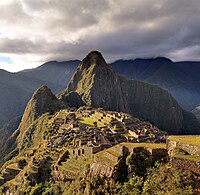
Back أساطير الإنكا Arabic Mitoloxía incaica AST Mitologia inca Catalan Mythologie der Inka German Mitolociya İnka DIQ Μυθολογία Ίνκα Greek Mitología incaica Spanish Inkojen mytologia Finnish Mythologie inca French המיתולוגיה של האינקה HE
 |
| Inca Empire |
|---|
| Inca society |
| Inca history |
Inca mythology is the universe of legends and collective memory of the Inca civilization, which took place in the current territories of Colombia, Ecuador, Peru, Bolivia, Chile, and Argentina, incorporating in the first instance, systematically, the territories of the central highlands of Peru to the north.
Inca mythology was successful due to political, commercial, and military influence, before the conquest of the territories to the south and north of Cuzco, which later gave rise to the nascent empire. The identity of the Quechua peoples in Peru and Bolivia; and the Quichuas (Kichwa) in Ecuador; they share this spatial and religious perception that unites them through their most significant deity: the god Inti.
Inca mythology was nourished by a series of legends and myths of their own, which sustained the pantheist religion of the Inca Empire, centralized in Cusco. The Inca people worshiped their gods, as in other religions. Some names of gods were repeated or were called in the same way in different provinces of the Inca people. Later, all these gods were unified and formed what is called the true Inca pantheon.
What was applied by the Inca cosmogony in the field of beliefs should be considered as one of the most important instruments used in the process of the formation of the empire along with the economic, social, and administrative transformations.
In a general way, Inca mythology or religion includes many stories and legends that attempt to explain or symbolize Inca beliefs.[1]
- ^ Handbook of Inca Mythology by Paul Richard Steele, Catherine J. Alen